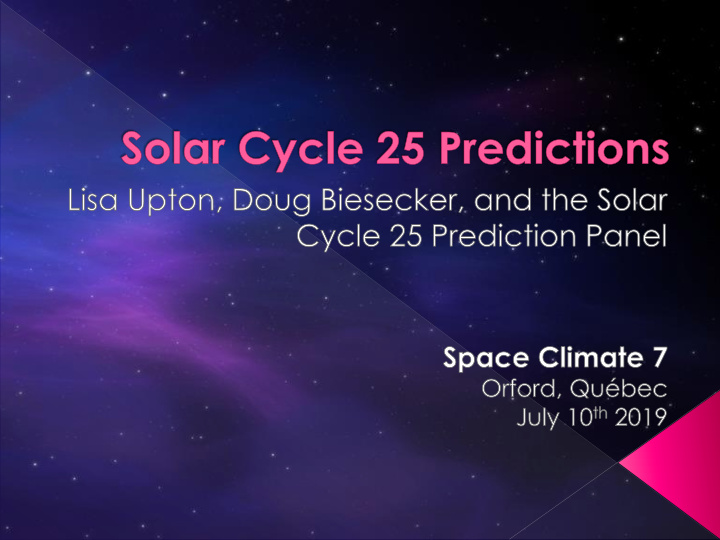



Required: Predict onset of Cycle 25/solar minimum Predict peak intensity and timing of Solar Cycle 25 in V2 of SSN If possible, also provide: Predict north/south hemispheres independently (intensity/timing) Predict F10.7/F30 Predict flare/CME rates
In December 2018, we put out a call for predictions in newsletters across the world. Predictions were accepted through February 1, 2019. We also conducted a literature review for published predictions.
Douglas Biesecker (NOAA) Co-chair, Lisa Upton (SSRC) Co-chair Robert Cameron (Max Planck), Frederic Clette (Royal Observatory of Belgium), Rachel Howe (Univ of Birmingham), Haruhisa Iijima (Univ of Nagoya), Bingxian Luo (NSSC), Andres Munoz-Jaramillo (SWRI), Gordon Petrie (NSO), Maria Weber (Univ of Chicago), Peter Wintoft (LUND), Nathan Smith (2nd Weather Squadron)
T < 1893 T > 1893 SSN V1 1. 0.6 SSN V2 1.666666 1. Rudolph Wolf created the first The SSN V2 is now Normalized to modern count, stitching together 1.0, while earlier data is adjusted. observations from 1749-1893 Based on the Standard 82mm › He tried to mimic early refractor: observers by artificially All spots are resolved › lowering his count Equivalent to counts done today › In 1893, Wolfer took over and Consistent with raw numbers from determined the a scaling of 0.6 most individual observers scaling required to keep modern Keeping the old scale is now count consistent with Wolf pointless: There are other conversion factors Now, more than 130 years with the › or inconsistencies that needed to modern scale be accounted for, but this Instantaneous conversion on PC › Renormalization is the primary No other change needed in the change in the SSN. future: For the full story see Clette et al. › Only early numbers adjustments, as 2014 part of the recalibration.
Cycle 24 peak was 81.9 in April 2014 (forecasted 90) The SSN V2 cycle 24 peak is 116.4 (42% higher) Cycle 24 The average peak for all cycles was 112.7 The new average peak is 179.4 (59% larger) Cycle 24 4 th smallest (Dalton Minimum ~30% smaller) All 24 Cycles
In July 2015 the Solar Influences Data Center started publishing daily sunspot numbers with Modern scale NOAA had already published predictions for the solar cycle – they decided to wait till minimum to switch. Users had experience using older numbers SWPC continues to correct sunspot number › Their factor is closer to 0.7 › Will remove this correction during the next solar minimum › Should be a relatively seamless transition Plenty of time to ensure users understand before Cycle 25 gets going
We considered ~60 predictions for Cycle 25 Different Classes of Predictions › Climatology › Dynamo › Machine Learning / Neural Networks › Precursor › Spectral › Statistical › Surface Flux Transport › Other
About ½ used the old SSN V1 scaling, and ½ used the new Modern SSN V2 scaling Includes multiple predictions by same author
Figure curtesy of Maria Weber Range of Values between ~30-250 (V2) V1: ~18-150 (V1) vs. SC 24 ~40-210
Figure curtesy of Maria Weber Cycle 25 will be similar in size to cycle 24: Peak amplitude somewhere between 95 and 130
SHOW A PLOT WITH LAST 5 SOLAR CYCLES TO SHOW THAT DOWNWARD TREND IS NOT CONTINUING FOR CYCLE @%
Timing of minimum: 2019.5-2020.75
Figure curtesy of Maria Weber Cycle 25 maximum will occur no earlier than the year 2023 and no later than 2026
Panel recognizes that Hemispheric Asymmetry ❖ needs further investigation. This may not significantly impact the prediction. ❖ We hope to be able to say which hemisphere ❖ will lead, relative amplitude, and if there will be a significant delay between the hemispheres.
Timing of minimum: 2019.5-2020.75 Timing of maximum: 2023-2026 SSN V2 Amplitude: 95-130 Solar Cycle 25 will be similar to SC24
Investigate the Hemispheric Asymmetry and Phasing Produce the Official SSN Prediction Curve Provide a statistical estimate of F10.7 Flux Attempt to create a Flare and CME Probability Forecast
We used the AFT SFT model to predict the polar field evolution: will be ~ 95-97% of SC 24
Timing of minimum: 2019.5-2020.75 We haven't reached solar minimum yet!!
http://sidc.be/news/x101x/welcome.html Jan, 2008 We haven't reached solar minimum yet!!
SolarCycleScience.com
The Sunspot Number has been revised › NOAA will be adopting these We haven't reached solar minimum Solar Cycle 25 similar to Cycle 24 › Amplitude of 95-130 › Maximum between 2023-2026 We are not in a Maunder Minimum Investigate Hemispheric Asymmetry Predict F10.7/F30 and flare/CME rates My personal prediction (~97% of SC24) SolarCycleScience.com
Recommend
More recommend